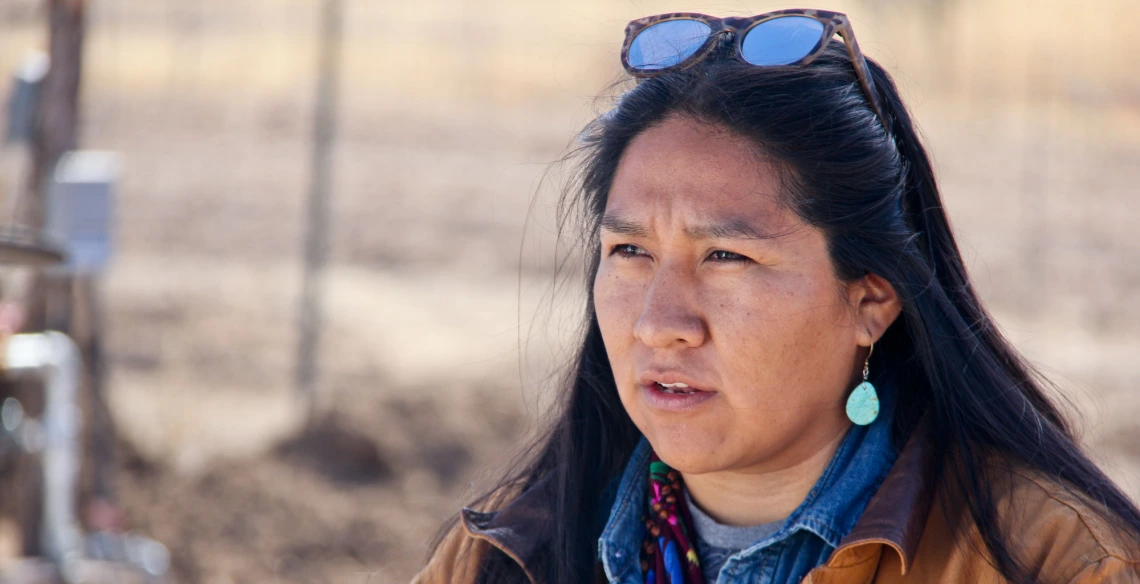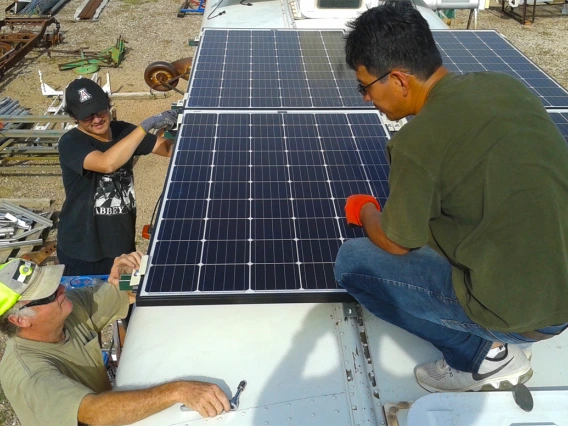UA Engineers Bring Life Source to San Carlos Apache Community
Engineers Without Borders and the University of Arizona partner with nonprofit to revitalize 80 acres on the San Carlos Apache Indian Reservation.

Carrie Curley, Nalwoodi Denzhone Community board member and San Carlos Apache: “Water is life, and we want clean water.” (Photo: Pete Brown/UA Engineering)
When Madchien Thompson turns on a faucet in her home on the San Carlos Apache Indian Reservation, the water sometimes comes out purple.
Parts of the community’s groundwater have high levels of arsenic, a known carcinogen, and there are frequent reports of E. coli contamination.
“That’s a big concern,” said Thompson, secretary of Arizona’s Nalwoodi Denzhone Community, or NDC. “There’s a lot of cancer in the community.”
The UA chapter of Engineers Without Borders, or EWB, and Vicky Karanikola -- research professor in the UA Department of Chemical and Environmental Engineering and postdoctoral research fellow at Yale University -- are teaming up with NDC to revitalize 80 acres of reservation land into the Nnee Nalwoodi, or Strong Apache Life Center.
And it all starts with clean water.
Next Stop for Water Purification Bus Technology
“The Nalwoodi Denzhone Project is very important,” said Carrie Curley, NDC board member and San Carlos Apache who drives to nearby Globe with her family to pick up five-gallon tanks of water for cooking and drinking. “Water is life, and we want clean water.”
While EWB offers consulting on how to restore the property’s two wells and develop an irrigation system, Karanikola is developing a system to purify and assess water quality. Karanikola, who is also vice president of the Mountain Regional Steering Committee for EWB, was part of a team of UA researchers who helped design and create a solar-powered water-purification bus for the Navajo Nation in 2017.
Like the bus, the purification system for San Carlos will involve drawing up water through wells and passing it through filters with micron ratings of 10, 5, then 1. A micron is one millionth of a meter, or about one-fiftieth the diameter of the average human hair. The filtered water is then squeezed through semipermeable membranes, and the leftover concentrate can be used for agriculture. Both projects are simple to use by design, so community members will ultimately be able to operate the systems themselves, without depending on engineers.
“For me, and I bet for a lot of people in our chapter, I can’t believe I am here in the safety of my home, and three hours away there are people who don’t have access to clean water or proper sanitation,” said Karanikola.
EWB member Catalina Fernandez-Moores, who recently graduated with a UA bachelor’s degree in biosystems engineering and will be completing her master’s degree next year, said the chance to work on projects such as this is what led her to the field she is in today.
“Really, Engineers Without Borders is what made me become an engineer. It not only gives you the technical know-how to solve problems, but it has the human side, too,” she said.
Cultivating Hope, Growing Fresh Food
Community members will come together at the Strong Apache Life Center to preserve their language and culture, hold summer camps for children, offer workshops on everything from budgeting to time management, and grow, eat and sell their own food.
Many people on the reservation don’t eat fresh fruits and vegetables because they are expensive and hard to come by -- there’s only one grocery store for the entire reservation.
“We don’t have fresh fruits and vegetables very often,” said Christy Sangster-Begay, a parent in the NDC summer program. “Having a place where we could go out and pick our own produce would be ideal. The youth need a place to reconnect to nature, and this place exactly provides it.”
A culture of hopelessness in which, as of 2015, 46 percent of people lived below the federal poverty line and, as of 2017, a quarter of residents had less than a ninth-grade education, perpetuates an environment in which the leading cause of death for adults is alcoholic liver disease.
“There’s a lot of stuff that can get you down, but having a center like this can bring a lot of joy,” said Juan Arias, a program coordinator with the UA College of Agriculture and Life Science’s Cooperative Extension Program. “Having a model for the tribe to show what can happen with the support of the tribe can be a catalyst for other projects to help build the community.”


